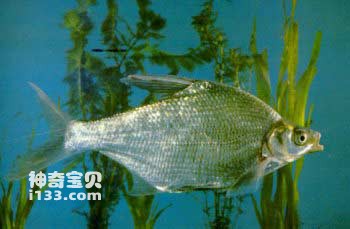Bream (Megalobrama skolkovii) belongs to the order Cypriniformes, family Cyprinidae, subfamily Megalobrama skolkovii, and genus Megalobrama skolkovii. Commonly known as: triangle bream, black bream, flat-breasted bream. English name: Black bream.
The body is tall, very flat on the sides, in a diamond shape, and the back of the head is bulging. The head is small and the mouth is located at the end; the front edges of the upper and lower jaws have well-developed cuticles. The ventral rib only extends from the base of the pelvic fin to the anus; the dorsal fin has smooth hard spines, the length of which is significantly longer than the head length; the length of the caudal peduncle is greater than or equal to the height of the caudal peduncle. The back of the body is bluish gray, the sides are light gray with light green, the belly is silvery white, the back of each scale is darker, and each fin is bluish gray.

Bream are found in flowing or still water bodies. It especially likes to inhabit open water areas where the substrate is silt or gravel, and there are submerged plants and freshwater shell vegetables. During the reproductive season, mature broodstock gather in places with flowing water to breed; in early spring, they swim to the banks of rivers, harbor branches and ancillary water bodies to feed. Bream is an omnivorous fish. Juveniles feed on freshwater shell vegetables as their main food, followed by insects and mollusk larvae. Adult fish feed on aquatic plants as their main food, followed by freshwater shell vegetables. Sexually mature individuals are 3 years old and weigh about 1 kg. Spawning grounds require significant water movement.
Widely distributed, it is produced in Heilongjiang, Yalu River, Liaohe River, Yellow River, Huaihe River, middle and lower reaches of Yangtze River, Qiantang River, Minjiang River and other water systems.
It grows quickly and is relatively large. The largest individual can reach about 5 kilograms. It has a certain yield in natural waters. The meat is delicious, tender and has high fat content. Each edible portion contains 18.5 grams of protein, 6.6-8.0 grams of fat, 0.2 grams of carbohydrates, 134 kcal of calories, 76 mg of calcium, 211 mg of phosphorus, and 2.2 mg of iron. Since ancient times, it has been popular among the people and regarded as the best edible fish. As early as more than 2,000 years ago, our ancestors loved to eat this kind of fish. For example, there is a poem in the "Book of Songs" that says, "If you don't eat fish, you will eat bream in the river." The morphological characteristics of bream, bream and bream are very similar, and they were collectively called "bream" or "bream" in ancient times. Li Shizhen wrote in "Compendium of Materia Medica": "Fang means Fang; bream means Bian." It can be seen that bream and bream are named according to their appearance.
The scaled, gutted and washed bream is used fresh. It has the effect of regulating the stomach and strengthening the spleen. It is mainly used to treat indigestion, chest and abdominal distension and other symptoms.
animal tags:
We created this article in conjunction with AI technology, then made sure it was fact-checked and edited by a Animals Top editor.